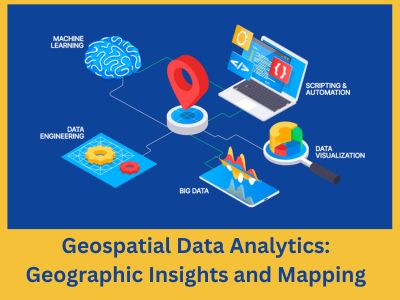
Introduction
Geospatial data analytics is a transformative field that harnesses the power of location-based information to extract valuable insights, make informed decisions, and create dynamic maps. In today’s data-driven world, understanding the significance of geospatial data is essential for businesses, governments, and individuals. This article explores the world of geospatial data analytics, its applications, and the impact it has on various industries.
The Essence of Geospatial Data
Geospatial data, also known as geographic or spatial data, is information that has a specific geographic location or a spatial component. It includes data points like latitude and longitude, physical addresses, postal codes, and more. This data can be collected from various sources, such as GPS devices, satellites, remote sensors, mobile apps, and even social media check-ins.
Applications of Geospatial Data Analytics
Urban Planning: Geospatial data is invaluable in urban planning, helping cities optimize transportation systems, allocate resources efficiently, and plan for sustainable growth.
Agriculture: Farmers use geospatial data to monitor crop health, optimize irrigation, and predict crop yields, leading to better agricultural practices and higher productivity.
Environmental Conservation: Geospatial data is crucial for monitoring and managing natural resources, tracking deforestation, wildlife migration patterns, and assessing the impact of climate change.
Logistics and Supply Chain: Companies use geospatial analytics to optimize routes, track shipments, and manage inventory efficiently.
Healthcare: Geospatial data aids in mapping disease outbreaks, identifying healthcare facility locations, and assessing public health risks.
Market Analysis: Businesses use location data to understand customer demographics, preferences, and shopping behaviors, enabling targeted marketing strategies.
Disaster Management: Geospatial analytics is vital for disaster preparedness and response, helping authorities coordinate rescue efforts and allocate resources effectively.
Real Estate: It assists in property valuation, site selection, and urban development planning.
Mapping and Visualization
One of the most recognizable outputs of geospatial data analytics is mapping and visualization. Geographic Information Systems (GIS) and mapping software allow professionals to create visually appealing and informative maps. These maps help convey complex information in an understandable manner, enabling better decision-making.
Impact on Business and Society
The integration of geospatial data analytics has far-reaching effects. For businesses, it provides a competitive advantage by enabling location-based marketing, improving operational efficiency, and supporting data-driven decision-making. In society, it facilitates disaster management, environmental conservation, and infrastructure planning. Additionally, geospatial data plays a crucial role in smart city initiatives, ensuring sustainability and quality of life.
Challenges and Future Trends
Challenges in geospatial data analytics include privacy concerns, data accuracy, and integration with other data sources. However, as technology advances, we can expect more accurate and real-time data collection, enhanced machine learning algorithms, and the integration of geospatial data with the Internet of Things (IoT) for comprehensive insights.
Conclusion
Geospatial data analytics has transformed the way we understand and interact with the world. By harnessing geographic information, we gain valuable insights into our surroundings, enabling us to make informed decisions and create innovative solutions. As this field continues to evolve, the applications and impact of geospatial data analytics will only become more pronounced, shaping a more efficient, sustainable, and informed world. To dive deeper into the world of data analytics, consider enrolling in the best online data analytics course in Hisar or explore the best offline data analytics course in Noida for hands-on expertise in this transformative field.




